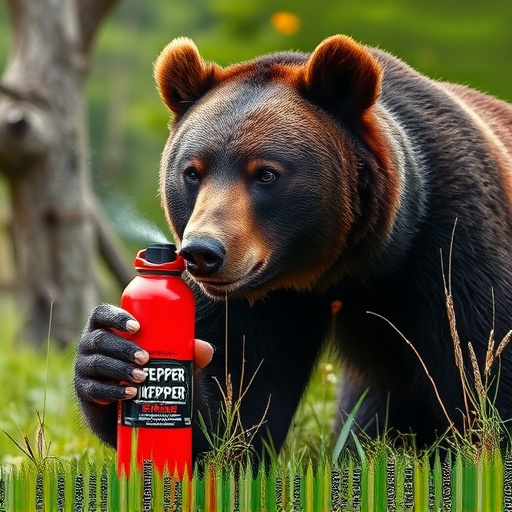Before entering national parks with bears, understand local Bear Spray Laws, learn proper usage, and choose appropriate products. Store and deploy bear spray safely, considering weather, terrain, and ecosystem impact. Adhere to park regulations to ensure safety for humans and wildlife.
“Enhance your safety during outdoor adventures in national parks with a powerful tool: bear spray. This comprehensive guide explores the effectiveness of bear spray in deterring predators, offering insights into its role as a vital defense mechanism. We’ll navigate legal considerations surrounding bear spray ownership and use within national parks, ensuring you understand the rules. Learn how to choose the right spray for your needs and master safety tips for optimal protection.”
- Understanding Bear Spray Effectiveness in National Parks
- Legal Considerations: Bear Spray Ownership and Use
- Choosing the Right Bear Spray for Your Adventure
- Safety Tips: Proper Usage and Storage Techniques
Understanding Bear Spray Effectiveness in National Parks
In many national parks across the globe, carrying bear spray is not just recommended but often mandated by law. Understanding the effectiveness of bear spray in these protected areas is crucial for visitors’ safety. Bear spray, also known as pepper spray or capsaicin spray, is designed to disable a predator’s sense of smell and sight temporarily, providing an escape route. Research shows that when used correctly, bear spray can significantly reduce attack risks, especially during surprise encounters.
However, it’s essential to remember that no deterrent is 100% effective against all predators in every situation. Bear spray laws in national parks vary; some allow its use for self-defense, while others restrict its application to specific scenarios. Visitors should familiarize themselves with local regulations and learn proper usage techniques before venturing into bear country to ensure maximum safety and minimize potential harm to both humans and wildlife.
Legal Considerations: Bear Spray Ownership and Use
Before considering bear spray as a defense mechanism in national parks or wild areas, it’s crucial to understand the legal considerations surrounding its ownership and use. Bear spray laws vary significantly from one region to another, with some states and national parks allowing its possession while others strictly prohibit it. National parks often have strict regulations regarding weapons, including bear spray, to ensure visitor safety and maintain natural habitats undisturbed.
Visitors should always check the specific rules of the park they plan to visit. Failure to comply with these laws can result in fines or other penalties. Additionally, proper usage training is essential, as incorrect application of bear spray could be ineffective or even dangerous. Understanding local regulations and learning how to use bear spray responsibly are critical steps for anyone venturing into bear country.
Choosing the Right Bear Spray for Your Adventure
When planning an outdoor adventure, especially in areas known for bear populations, selecting the appropriate bear spray is paramount. The market offers various options, each with distinct features and efficiencies. Key factors to consider include spray range, concentration of capsaicin (the active ingredient), and the can’s durability. Understanding local bear spray laws specific to national parks or wilderness areas is also crucial before your trip. These regulations dictate permitted strengths, sizes, and carrying requirements, ensuring responsible use and minimizing ecological impact.
For instance, some parks may restrict high-concentration sprays to mitigate potential harm to local ecosystems. Users should opt for products that align with these guidelines while offering adequate protection. Additionally, considering factors like weather conditions and terrain can further optimize spray effectiveness. Proper training on usage is equally vital, as it ensures you can deploy the spray quickly and accurately when faced with a predator encounter.
Safety Tips: Proper Usage and Storage Techniques
Using bear spray correctly and storing it properly is crucial for safety in national parks where bear encounters are common. Always check local Bear Spray Laws before visiting any park, as regulations can vary. When deploying bear spray, remember to point the nozzle away from yourself and other people. Aim high, towards the predator’s face and chest, because bears have a large lung capacity that allows them to inhale quickly. Use quick, short bursts—3 to 5 seconds—and move away at an angle after deployment, allowing the wind to carry the spray away from you.
Store bear spray in a secure, dedicated container within easy reach. Keep it out of direct sunlight and extreme temperatures, as these conditions can affect its effectiveness. Never leave bear spray unattended or stored in a vehicle, especially during warm weather. Ensure children and pets understand the dangers of bear spray and that it should only be used as a last resort. Regularly inspect your bear spray for any signs of damage or degradation, replacing it according to manufacturer recommendations to maintain optimal protection.
Bear spray can be a valuable tool for self-defense in national parks where bear encounters are common. Understanding its effectiveness, legal considerations regarding ownership and use, proper selection, and safe handling techniques is crucial for anyone venturing into bear country. By adhering to local Bear Spray Laws in National Parks, you can enhance your safety while enjoying the outdoors and minimize potential conflicts with these majestic animals. Always remember that prevention through awareness and distance is key, but having bear spray as a backup option can provide peace of mind during your adventures.
